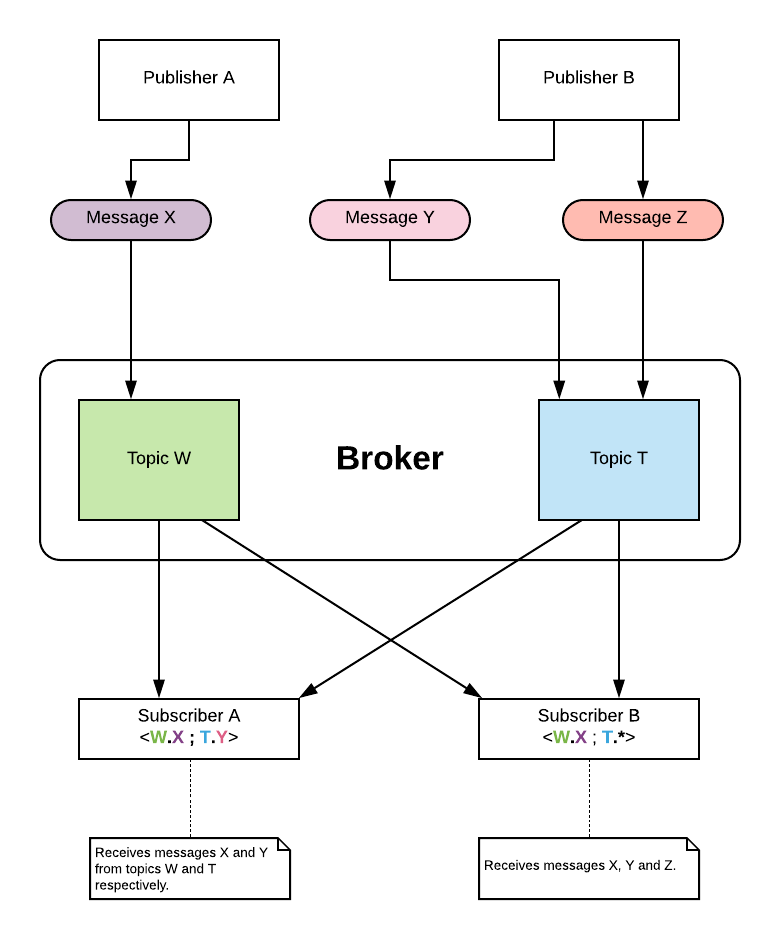The go-pubsub package is a simple package for implementing publish-subscribe
asynchronous tasks in Golang. It allows writing publishers and subscribers fully
statically typed, and swap out Broker implementations (e.g. Memory, AWS SQS,
etc.) as required.
This package imposes no restrictions on how messages should be represented, the idea is to keep subscribers agnostic to transport concerns and be fully typed using golang definitions. How messages are encoded/decoded in order to be transported over the network is up to the provider implementation in combination with Codec middlewares.
A PubSub system is a messaging system that has, as its name implies, two components: Publisher of messages and subscriber to messages. In contrast to synchronous communication, the publisher doesn't have to wait for a message to be received, as well as the receiver doesn't have to be online to retrieve messages sent earlier. As such, a PubSub system acts like a buffer for asynchronous messaging.
- Multi-topic support, the same subscriber may listen for messages on multiple topics at the same time.
- Hybrid message filtering, subscriber are free to decide whether they want to receive messages for a concrete type or not (content-based), or just receive everything that is pushed to a given topic/s (topic-based).
- Pluggable providers. Just implement the
Brokerinterface. See below for a list of built-in providers
Providers are concrete implementations of the Broker interface. Examples of providers could be messaging services such as Google's PubSub, Amazon's SNS or Nats.io. The Broker interface acts as a generalization for such services.
The go-pubsub package comes with a set of built-in providers:
memory: A simple, synchronous Broker for in-process message communication, acting as a straightforward "Message Bus" or "Event Dispatcher" replacement. It ensures message processing in publication order and allows error feedback to the consumer if a subscriber fails to process a message. Notably, it executes all subscribers, requiring idempotent handling for retry functionality, as subscribers may be invoked multiple times until successful processing.nop: a simple NO-OP broker implementation that can be used for testing.redis: a broker that uses redis streams as PubSub mechanism.snssqs: a Broker that uses AWS SNS and AWS SQS.kmq: a KubeMQ implementation of the Broker interface.
This packages moves around the Broker interface definition, which is the
central piece for dealing with PubSub systems. The Broker interface is a
composition of three independent interfaces which can be used in order to keep
you application concerns clean and separated:
type Broker interface {
Publisher
Subscriber
Shutdowner
}
type Publisher interface {
Publish(ctx context.Context, topic Topic, m interface{}) error
}
type Subscriber interface {
Subscribe(ctx context.Context, topic Topic, handler Handler, option ...SubscribeOption) (Subscription, error)
}
type Shutdowner interface {
Shutdown(ctx context.Context) error
}Creating your own provider is as simple as implementing the Broker interface described above.
A middleware acts as a wrapper for a Broker implementation. It can be used to intercept each message being published or being delivered to subscribers. Users can use middleware to do logging, metrics collection, and many other functionalities that can be shared across PubSub Providers.
To use middleware capabilities you must simply wrap your broker using any of the provided middlewares, example:
broker := printer.NewPrinterMiddleware(myProvider, os.Stdout)Included middlewares are:
codec: a middleware that encodes and decodes messages using the given codec.lifecycle: a middleware that allows to bind to broker lifecycle events.printer: a simple middleware that prints each message to the given output.recover: a middleware that recovers from panics.retry: a middleware that retries publishing messages if the broker fails.
Middlewares can be combined by wrapping each other, for example:
broker := memory.NewMemoryBroker()
broker = printer.NewPrinterMiddleware(myProvider, os.Stdout)
broker = codec.NewCodecMiddleware(broker, codec.JSON)
broker = recovery.NewRecoveryMiddleware(broker, func(ctx context.Context, p interface{}) error {
println("panic:", p)
return nil
})Please note that middlewares are applied in reverse order they are wrapped, so in
the example above, the recovery middleware will be applied first, then the
codec middleware, and so on:
Recovery -> Codec -> Printer -> Memory-Broker
- Kafka provider
- Google's Pub/Sub provider
- Nats.io provider
- Redis provider
- Add protobuf support as a middleware codec
- Recovery middleware for dealing with panics
- Retry middleware for dealing with unreliable providers/handlers
package main
import (
"context"
"fmt"
"time"
"github.com/botchris/go-pubsub"
"github.com/botchris/go-pubsub/provider/memory"
)
var myTopic pubsub.Topic = "my-topic"
type myMessage struct {
Body string
}
func main() {
ctx, cancel := context.WithTimeout(context.Background(), 5*time.Second)
defer cancel()
broker := memory.NewBroker()
// Define handlers
h1 := pubsub.NewHandler(func(ctx context.Context, t pubsub.Topic, m myMessage) error {
fmt.Printf("%s -> %+v -> [s1]\n", t, m)
return nil
})
h2 := pubsub.NewHandler(func(ctx context.Context, t pubsub.Topic, m *myMessage) error {
fmt.Printf("%s -> %+v -> [s2]\n", t, m)
return nil
})
h3 := pubsub.NewHandler(func(ctx context.Context, t pubsub.Topic, m string) error {
fmt.Printf("%s -> %+v -> [s3]\n", t, m)
return nil
})
// Subscribe to topic
var s1 pubsub.Subscription
{
s1l, err := broker.Subscribe(ctx, myTopic, h1)
if err != nil {
panic(err)
}
s1 = s1l
if _, sErr := broker.Subscribe(ctx, myTopic, h2); sErr != nil {
panic(sErr)
}
if _, sErr := broker.Subscribe(ctx, myTopic, h3); sErr != nil {
panic(sErr)
}
}
// Publish test messages
{
if err := broker.Publish(ctx, myTopic, myMessage{Body: "value(hello world)"}); err != nil {
panic(err)
}
if err := broker.Publish(ctx, myTopic, &myMessage{Body: "pointer(hello world)"}); err != nil {
panic(err)
}
if err := broker.Publish(ctx, myTopic, "string(hello world)"); err != nil {
panic(err)
}
// Unsubscribe S1
if err := s1.Unsubscribe(); err != nil {
panic(err)
}
// This will noop
if err := broker.Publish(ctx, myTopic, myMessage{Body: "value(hello world)"}); err != nil {
panic(err)
}
}
// Output:
// {Body:value(hello world)} -> my-topic -> [s1]
// &{Body:pointer(hello world)} -> my-topic -> [s2]
// string(hello world) -> my-topic -> [s3]
// <nothing>
}